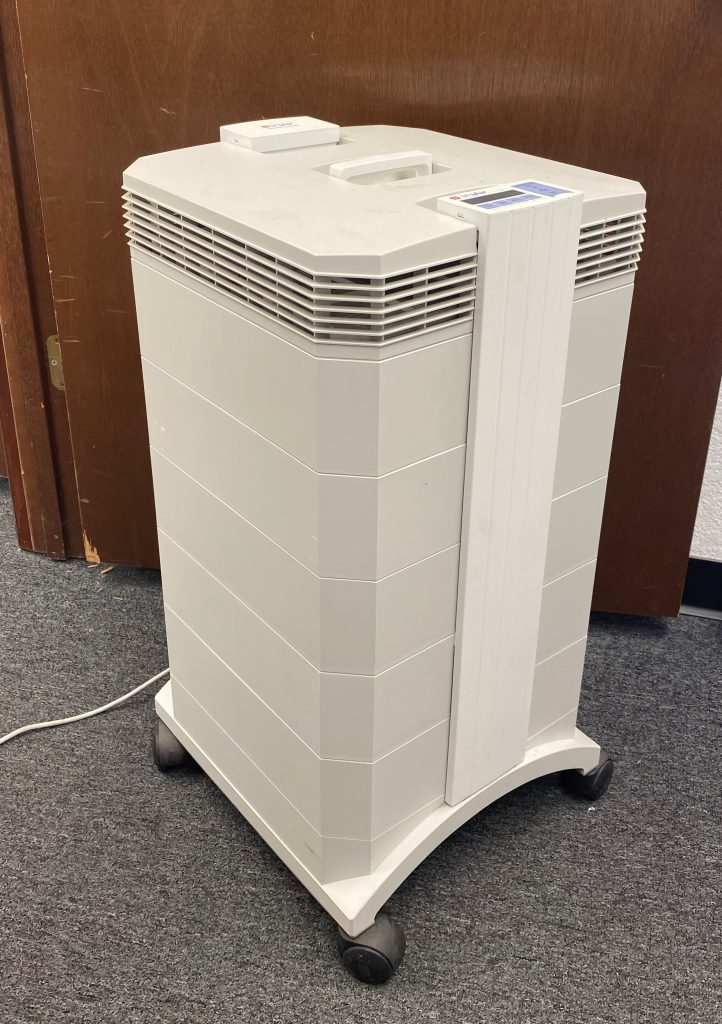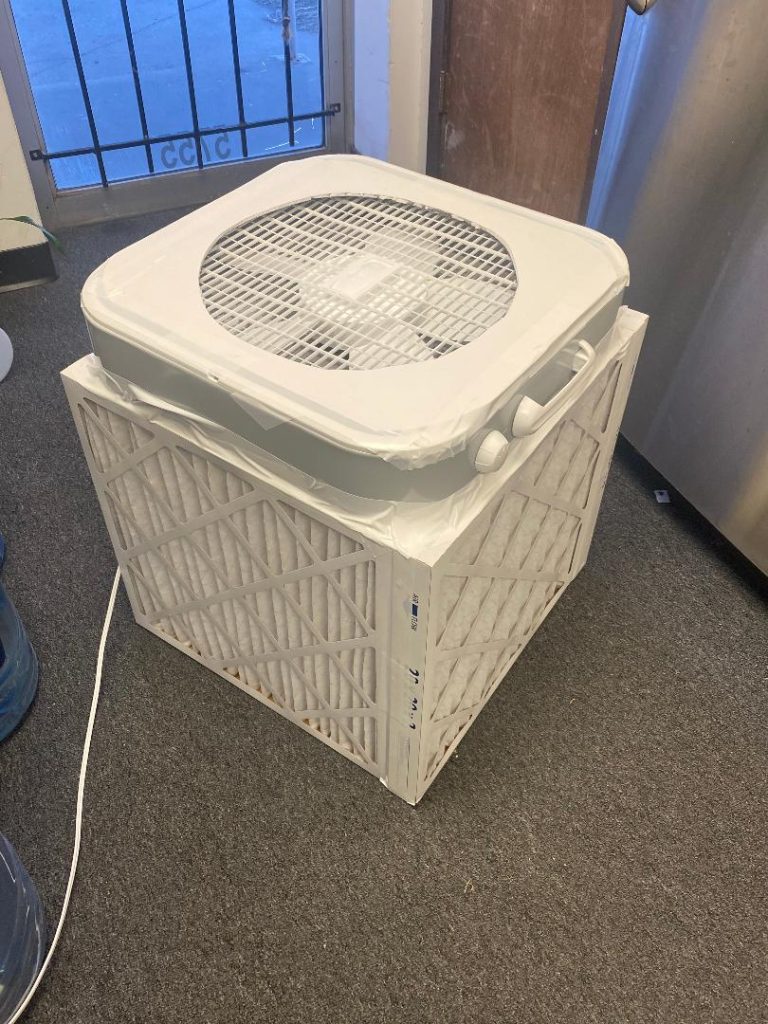The main reason to use an air cleaner is to remove particles – the higher the particle removal rate, the more effective the air cleaner. What factors determine effectiveness? The first element is the FILTER. An efficient filter is critical. But, the filter is only as good as the construction of the air cleaner. The filter must FIT properly into the system. Finally, an air cleaner still needs to move the air to clean the air. So an air cleaner must have FLOW. It is the combination of these three factors – Filter + Fit + Flow – that determines air cleaner effectiveness.
To illustrate this point we tested two air cleaners and compared the results. One of the air cleaners is an IQ Air. The other is a DIY Corsi/Rosenthal Box using MERV 13 filters.
The IQ Air has an excellent HEPA filter. We tested it using a Lighthouse Handheld 3016-IAQ particle counter. Here are the results:
| Particle Size | Ambient – Part/cub. Foot | IQ Air | Efficiency |
| 0.3 um | 1009400 | 900 | 99.911% |
| 0.5 um | 51800 | 200 | 99.614% |
| 1 um | 2300 | 0 | 100% |
| 2.5 um | 400 | 0 | 100% |
| 5 um | 200 | 0 | 100% |
| 10 um | 200 | 0 | 100% |

Here are the results of the same efficiency test on a Corsi/Rosenthal Box Air Cleaner made from 4 – 20X20X2 MERV 13 filters and a Lasko Box Fan:
| Particle Size | Ambient – Part./cub. Foot | CR Box MERV 13 | Efficency |
| 0.3 um | 762200 | 291600 | 61.742% |
| 0.5 um | 73000 | 21500 | 70.548% |
| 1 um | 19400 | 5200 | 73.196% |
| 2.5 um | 8700 | 0 | 100.000% |
| 5 um | 2700 | 0 | 100.000% |
| 10 um | 2100 | 0 | 100.000% |

Tests were conducted in a 22’X26’X8′ room (total volume – 4,576 cubic feet). The IQ Air was operated at it’s highest speed of 300 cfm. Noise level at this speed was 63 db. Tests results were the following:
| Particle Size | Start – Part./ cubic ft. | 30 minutes | % Reduction | 60 Minutes | % Reduction |
| 0.3 um | 1409500 | 459300 | 67.41% | 381900 | 72.91% |
| 0.5 um | 311800 | 27900 | 91.05% | 24000 | 92.30% |
| 1 um | 201600 | 2900 | 98.56% | 3600 | 98.21% |
| 2.5 um | 131000 | 600 | 99.54% | 1100 | 99.16% |
| 5 um | 48500 | 300 | 99.38% | 300 | 99.38% |
| 10 um | 29100 | 100 | 99.66% | 100 | 99.66% |
The room was allowed to “recover” for one hour. Particles were added with a salt spray. The Corsi/Rosenthal box was operated at it’s lowest speed. (Air velocity at exit = 620fpm. 15″ shroud. Flow rate = 760 cfm) Noise 52 db. The results were the following:
| Particle Size | Start – Part./ cubic foot | 30 minutes | % Reduction | 60 minutes | % Reduction |
| 0.3 um | 777000 | 277000 | 64.35% | 275800 | 64.50% |
| 0.5 um | 143000 | 12300 | 91.40% | 9000 | 93.71% |
| 1 um | 71300 | 3200 | 95.51% | 1900 | 97.34% |
| 2.5 um | 42100 | 900 | 97.86% | 600 | 98.57% |
| 5 um | 17200 | 400 | 97.67% | 0 | 100.00% |
| 10 um | 11400 | 0 | 100.00% | 0 | 100.00% |
This first set of tests gives us some very helpful information. For example, the CR box with MERV 13 filters produced lower particle counts in all size ranges 0.3-10um than the HEPA air cleaner. The higher flow rate provided for more passes through the filters and more than compensated for the lower filter efficiency. However, the room did not recover fully between tests so the baseline was lower for the Corsi/Rosenthal Box. At one hour of operation particle levels for both filters had stabilized. The levels were lower for the CR box and were unlikely to change with more time.
In order to verify the results we repeated the test in a different indoor space. This space was two rooms joined by a common door. One room is 22’X16’X8′. The second room is 20’X16’X8′. The air cleaners were placed in the first room. Here are the results for the IQ Air as measured in Room 1.
| Particle Size | Ambient-Part./ cubic ft. | 20 minutes | % Decrease | 40 minutes | % Decrease | 60 minutes | % Decrease |
| 0.3 um | 1219000 | 141000 | 89.01% | 108700 | 91.08% | 88200 | 92.76% |
| 0.5 um | 629700 | 22200 | 96.96% | 12400 | 98.03% | 11700 | 98.14% |
| 1 um | 348200 | 7200 | 98.46% | 2500 | 99.28% | 1900 | 99.45% |
| 2.5 um | 160800 | 2000 | 99.14% | 800 | 99.50% | 300 | 99.81% |
| 5 um | 47700 | 500 | 99.45% | 100 | 99.79% | 100 | 99.79% |
| 10 um | 29700 | 300 | 99.53% | 100 | 99.66% | 100 | 99.66% |
Here are the results from the Corsi/Rosenthal box in Room 1:
| Particle Size | Ambient – Part./ Cubic Ft. | 20 minutes | % Decrease | 40 minute | % Decrease | 60 Minute | % Decrease |
| 0.3 um | 1283400 | 87800 | 93.16% | 85900 | 93.31% | 77100 | 93.99% |
| 0.5 um | 730900 | 9200 | 98.74% | 7500 | 98.97% | 7700 | 98.95% |
| 1 um | 467500 | 1800 | 99.61% | 800 | 99.83% | 900 | 99.81% |
| 2.5 um | 232900 | 700 | 99.70% | 100 | 99.96% | 200 | 99.91% |
| 5 um | 91100 | 200 | 99.78% | 0 | 100.00% | 100 | 99.89% |
| 10 um | 63200 | 200 | 99.68% | 0 | 100.00% | 0 | 100.00% |
Once again the MERV 13 Corsi/Rosenthal box had lower particle counts at ALL particle sizes. This result is counter intuitive. One would think that the HEPA air cleaner with at least 99.99% efficiency in the six particle channels would have lower particle counts than a MERV 13 CR box with as low as 61.74% in the 0.3 um range. The much higher flow rate makes up for the lower efficiency.
A very important point is that the test was repeated multiple times with the same results. Critics may have some complaints about the methodology, but the fact that the different tests produced the same outcomes is compelling. The essence of scientific validity is the fact that the tests (or experiments) are repeatable. These are.
The takeaway is that filter efficiency is only one element in determining air cleaner effectiveness. It is the combination of Filter + Fit + Flow that produces the best results.